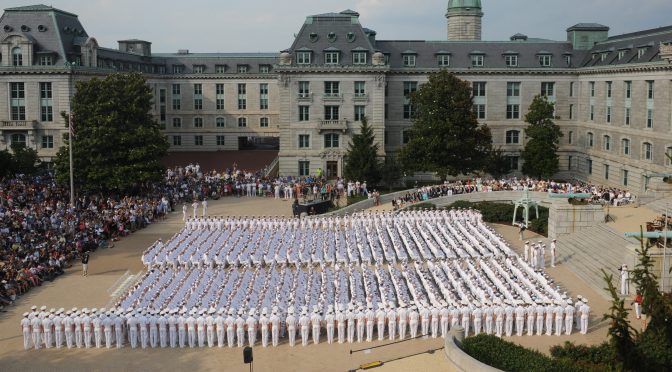By Dmitry Filipoff
We are excited to announce that the U.S. Naval Academy will be working with CIMSEC to promote the work presented at the 57th Naval Academy Foreign Affairs Conference (NAFAC). Taking place from April 11-13, NAFAC will bring together midshipmen and students from across the United States and around the world to discuss a theme of global importance. This year’s conference theme is “A New Era of Great Power Competition?”
During the week of the conference, CIMSEC will provide coverage of the event’s major proceedings with regular postings. The week after the conference CIMSEC will republish the top papers from each of the sixteen round tables facilitating debates on specific topics. Each round table involves three midshipmen on (one moderator, two delegates) as well as 8-10 external delegates (both domestic and international civilians and military delegates). Each round table will also have two senior advisers (one academic expert and one professional in the field covered). See the list of this year’s round table topics here.
Read on to learn more about this year’s conference and the purpose and history of NAFAC. From the U.S. Naval Academy website:
Despite the cost of being at war for over a decade, “America is still today the world’s foremost leader, partner, and underwriter of stability and security in every region across the globe.” However, a rising China and more belligerent Russia have moved to the forefront of American strategic thinking. Despite recent setbacks, India and Brazil will likely continue to rise. Key U.S. military and civilian leaders have acknowledged a return to great power politics. American global dominance may begin to expect competition from multiple powers around the world, a reality not seen since the Cold War. America’s current fiscal deficits continue to be high, while other economies are rivaling the United States. Rapid technological advances and the changing nature of warfare pose challenges to America’s military might. Given these trends, to what level should the U.S. strive to remain the world’s greatest power and security leader? Should great power status continue to be measured in traditional ways? NAFAC 2017 will examine the promise and constraints of the rising peer competitors. The conference will invite you to think not only about what these dynamics mean for the future of global power, but also what strategies America should take to effectively respond to this competition.
What is NAFAC
Each year since 1960, the U.S. Naval Academy has hosted a gathering of undergraduates from around the United States and the world who come together in the spring to discuss a theme from current global affairs.
The Naval Academy Foreign Affairs Conference (NAFAC) has grown to be the leading undergraduate conference in the country. It has welcomed delegates from thirty countries in each of the last five years and it has heard speakers as notable as President George Bush and Secretary of State Defense Robert Gates.
This conference provides an outstanding opportunity for the midshipmen to come to understand the global forces that may project them into duty in Afghanistan, the Middle East, Korea, North Africa or Latin America. Good officers need a sophisticated understanding of current affairs; this conference puts them together for a week with their civilian counterparts as well as with young officers and civilian delegates from about two dozen countries for conversations in which they can develop that understanding.
The Naval Academy Foreign Affairs Conference has grown in reputation but not in size. It is kept small – no more than one hundred fifty delegates–in order that the discussion groups which are at the heart of the conference retain a good seminar atmosphere. These round table discussions include ten university delegates, two or three foreign delegates, two midshipmen delegates, a midshipman moderator and two senior advisors.
NAFAC also offers an excellent occasion for the midshipmen to show off the Academy and the Navy at its best. Each year they produce an impressive event, handling without a visible hitch the many logistical difficulties of transporting, housing, feeding and entertaining scores of guests, some of them of flag rank or international reputation. As one former midshipman director said. “The Naval Academy aims to provide a laboratory where we can learn and practice the skills of leadership. Putting on this conference was the toughest leadership and logistical exercise I have faced here yet.
Dmitry Filipoff is CIMSEC’s Director of Online Content. Contact him at Nextwar@cimsec.org.
Featured Image:ANNAPOLIS, Md. (July 1, 2015) The 1,192 members of the U.S. Naval Academy’s incoming Class of 2019 gather in Tecumseh Court for the Induction Day Oath of Office Ceremony. Induction Day marks the beginning of Plebe Summer, the arduous six week indoctrination that transitions civilian students to military life. (U.S. Navy photo by Mass Communications Specialist 2nd Class Nathan Wilkes/RELEASED)

